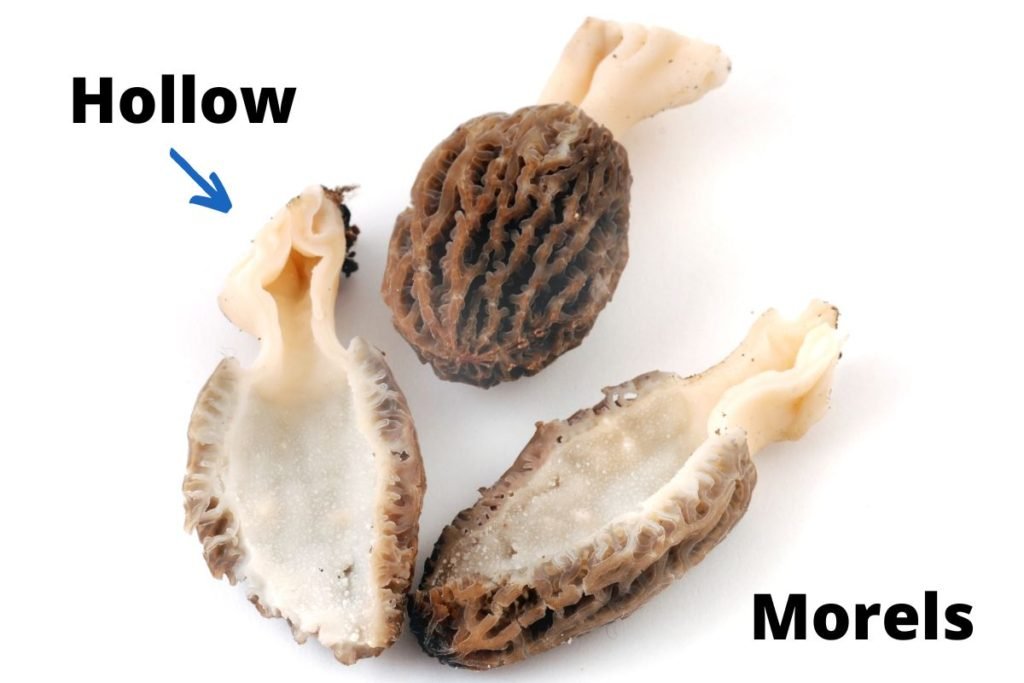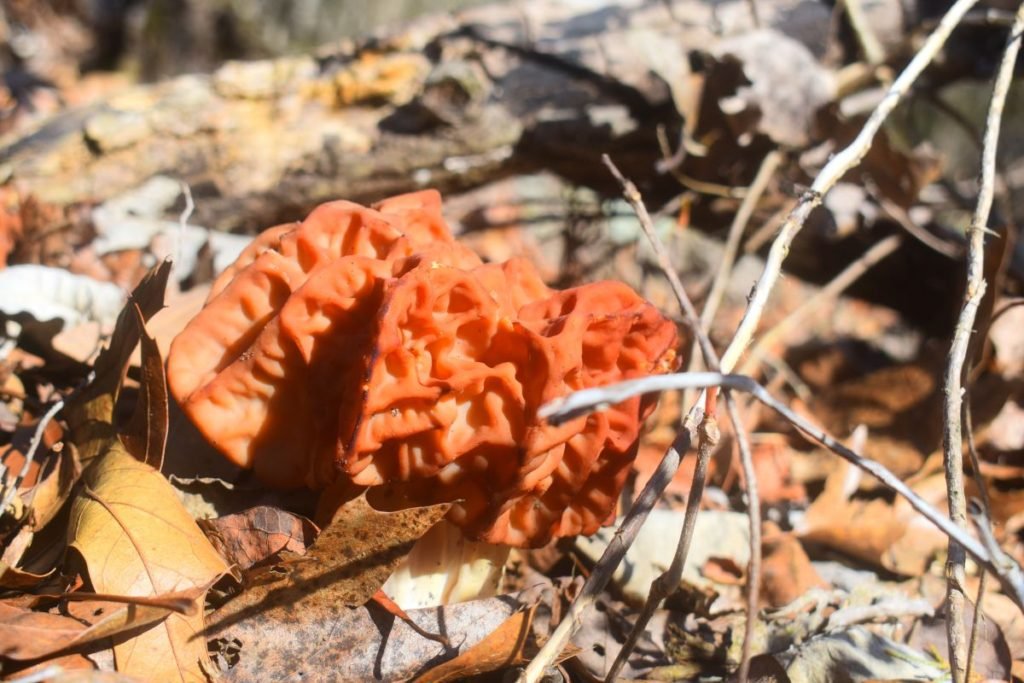Foraging for food is one of my favorite things to do when I get the chance. If you live outside of the city, you may be amazed at what edible foods you can find growing in your local environment.
One of my favorite things to do with food that I forage is cook homemade pizzas! Of all of the combinations I’ve come up with, morel mushrooms with arugula are just perfect for a forager’s pizza.
The material provided here is for educational, informational, and entertainment purposes only and is not intended as medical advice.
Learning what is edible and what is not is very important. We’re going to go over the delicious morel mushroom and the poisonous false morel, to help educate you on the differences between the two, and how you can identify them.
How can you tell a real morel from a false morel?
A true morel mushroom will be hollow. The false morel will have a fibrous interior that loos like cotton. To tell them apart, you must cut the mushroom in half from top to bottom. If the mushroom is hollow, it may be a morel mushroom, if it is not hollow, it is a false morel.
Now, let’s take a closer look at these two look-a-like mushrooms, learn where they grow, what conditions they grow in, and more.
What Does a Morel Mushroom Look Like
Morel mushrooms are small to large mushrooms that grow in the wild. They have oblong caps that look similar to the texture of a human brain! The stems are a white or off-white color and the caps are a variety of colors.
The shape of morels can vary. They may be oblong, or they can be more bulbous looking. The caps can also vary in color, from golden, to off-white, to brown, to dark brown.
Morels can be very hard to spot on the forest floor. Their unique texture makes it hard to spot them since the small crevices blend into so many other fine detailed things. You have to have a good eye when searching for them. Remember to scan areas more than once and with great detail.

Where Do Morels Grow?
Morels are a common mushroom. They grow in many different parts of the world. They can be found in forest beds, paths, near waterways, and in areas with slopes that face the sun.
Pretty much any wooded area that has the right amount of sunlight, warm soil, and other factors, could produce morel mushrooms. They love to grow around certain types of trees that drop water. They grow in the drip line that the water dropping from trees produces.
You can also find morels near areas where fire has burned part of the landscape. The burned soil creates an environment that morel mushrooms thrive in. As long as it gets enough sunlight, these burned patches can produce some of the best specimens of morels.
What Does a False Morel Look Like
The false morel looks similar to the true morel. However, there are many differences as well. A false morel is any mushroom that looks like the morel, several varieties are look-a-likes. Such as the Gyromitra esculenta and Verpa bohemica.
The Gyromitra is the most common false morel. It forms a brainy-looking cap just like the true morel. However, it usually has a red color. It often looks like it has been slightly melted as well. The caps are clumpy and large.
The Verpa bohemica, on the other hand, looks more like a true morel. The difference is that the true morel will be hollow inside, while the Verpa will not. The Verpa is attached to the top of the cap, while true morel is attached to the cap at the base.
The true morel mushroom’s cap is attached to the base (like one piece) without any veil. The false morel is attached at the top of the cap.
Where Do False Morels Grow?
False morels are found in many of the same types of places as true morels, however, they prefer mountainous regions. Even though they grow in higher elevations, they still thrive in forests, woods, and other places where the environment is just right.
Even if you have found a group of true morels, false morels could be nearby. Always check your morels by slicing them vertically to make sure they are hollow (true morels.)
Identifying Morel Mushrooms (Step by Step)
So now you know a few ways to tell if your morels are true morels or false morels. Let’s go through it step-by-step. You have used your knowledge of what a morel mushroom looks like, and where it grows, and now you want to make sure that it is a morel and not a false morel.
Step 1
If the mushroom appears to be a morel, find a sharp-bladed knife and prepare to cut the mushroom in two.
Step 2
Slice the mushroom in half, vertically. The inside of the cap and the stem should be hollow if it is a true morel.
Step 3
If it is not hollow and has a cotton-like fibrous inside, then you most likely have a false morel and you should discard it.
What Happens if you Eat a False Morel?
We know that false morels are toxic, but how toxic are they? Some people have no trouble eating false morels (we do not suggest eating them,) however, others have experienced extreme illnesses.
False morels can cause nausea, vomiting, abdominal pain, fatigue, dizziness, headache, diarrhea, bloating, muscle cramps, and even death. One study shows that 23% of mushroom-related deaths in Poland were from false morels. Source.
False Morel vs. Morel Similarities and Differences
Because there are many similarities between morel look-a-likes, we have created this chart to help you understand the differences.true morels and false morels have brainy-looking caps. False morels have solid caps instead of hollow ones. The true morel and Verpa false morel caps are usually gold, off-white, or brown in color. The Gyromitra false morel cap is sometimes red and mushy looking. The true morel is edible and can be used as a food source. Some claim false morels can still be eaten (bad advice.) The false morel is poisonous and should not be consumed. The true morel and Verpa false morel, look very similar, they are slender and vertical in appearance. The Gyromitra false morel cap sometimes looks melted and clumpy, very different from the true morel.
Are There Other Poison Morel Look-a-likes?
Yes, there are multiple morel look-a-likes. Here is our list of mushrooms or common names, that look like, and sometimes get confused with, true morel mushrooms.
- Verpa bohemica
- Gyromitra esculenta
- Half-free morel
- Big red false morel
- Gabled false morel
With so many look-a-likes out there it can be smart to keep some kind of book on mushrooms. While you can usually tell by slicing these in half, it is better to have as much information as you can. Source.
For more edible comparisons, check out our article Queen Anne’s Lace Vs Poison Hemlock.
Related Questions
Can you eat morels raw?
Morels should be cooked before eating. Eating raw morels can result in gastric upset. People who are allergic to morels would be more sensitive to eating raw morels rather than cooked.
Can dogs eat morels?
Yes, dogs can eat morel mushrooms. They are not toxic to dogs and can provide nutritional value. Dogs have strong digestion systems that will break down the compounds of the mushroom easily.


